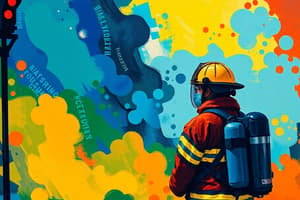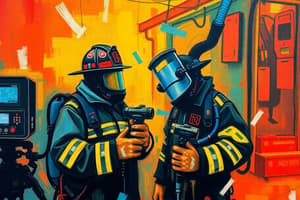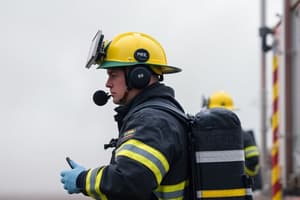Podcast
Questions and Answers
Who is responsible for implementing the air monitoring process?
Who is responsible for implementing the air monitoring process?
- The Safety Officer only
- The Incident Commander and/or Safety Officer (correct)
- The Fire Chief
- All emergency responders
At what CO level can respiratory protection be removed?
At what CO level can respiratory protection be removed?
- Less than 10 ppm
- Less than 35 ppm (correct)
- Less than 50 ppm
- Less than 75 ppm
How often must the atmosphere in the structure be rechecked after SCBA is no longer required?
How often must the atmosphere in the structure be rechecked after SCBA is no longer required?
- Every 5 minutes
- Every 20 minutes
- Every 10 minutes
- Every 15 minutes (correct)
What must the O2 levels be between for respiratory protection to be removed?
What must the O2 levels be between for respiratory protection to be removed?
What is the first step in post-incident air monitoring?
What is the first step in post-incident air monitoring?
Which meters are specified for monitoring air quality?
Which meters are specified for monitoring air quality?
What is an IDLH atmosphere?
What is an IDLH atmosphere?
Under what condition may a firefighter still be required to wear respiratory protection?
Under what condition may a firefighter still be required to wear respiratory protection?
What are the primary substances monitored according to the guidelines?
What are the primary substances monitored according to the guidelines?
Who is responsible for implementing the air monitoring process during an incident?
Who is responsible for implementing the air monitoring process during an incident?
When should air monitoring for IDLH atmospheres begin?
When should air monitoring for IDLH atmospheres begin?
Which equipment is mandated to be worn until authorized to doff during incidents?
Which equipment is mandated to be worn until authorized to doff during incidents?
What is required for the structure to be monitored for air quality levels?
What is required for the structure to be monitored for air quality levels?
What type of monitoring equipment is specified for air quality testing?
What type of monitoring equipment is specified for air quality testing?
What must air quality levels meet according to the guidelines?
What must air quality levels meet according to the guidelines?
What happens if monitoring indicates unsafe air quality levels?
What happens if monitoring indicates unsafe air quality levels?
What is the recommended exposure limit for CO according to NIOSH?
What is the recommended exposure limit for CO according to NIOSH?
Under what condition can respiratory protection be removed?
Under what condition can respiratory protection be removed?
What is the advised action if oxygen levels are below 20.9%?
What is the advised action if oxygen levels are below 20.9%?
How frequently should the atmosphere be monitored and rechecked once SCBA is deemed unnecessary?
How frequently should the atmosphere be monitored and rechecked once SCBA is deemed unnecessary?
What is the exposure limit for HCN as recommended by NIOSH?
What is the exposure limit for HCN as recommended by NIOSH?
What does the guideline indicate about the use of breathing protection?
What does the guideline indicate about the use of breathing protection?
What is the Immediately Dangerous to Life and Health (IDLH) level for HCN?
What is the Immediately Dangerous to Life and Health (IDLH) level for HCN?
What must be monitored if equipment is available, concerning VOCs?
What must be monitored if equipment is available, concerning VOCs?
What is the effective date of the Standard Operating Guideline SFD.084?
What is the effective date of the Standard Operating Guideline SFD.084?
Who is the first point of contact for questions regarding the SOG?
Who is the first point of contact for questions regarding the SOG?
What document revision number does SFD.084 currently hold?
What document revision number does SFD.084 currently hold?
Who approved SFD.084?
Who approved SFD.084?
What action can members take if they notice an error in the policy?
What action can members take if they notice an error in the policy?
When is the review date scheduled for SFD.084?
When is the review date scheduled for SFD.084?
What is stated regarding the legal implications of this policy?
What is stated regarding the legal implications of this policy?
What does the acronym SFD stand for in the context of this document?
What does the acronym SFD stand for in the context of this document?
Flashcards are hidden until you start studying
Study Notes
Post-Incident Air Monitoring
- The Incident Commander (IC) or Safety Officer is responsible for air monitoring after a fire.
- All firefighters must wear full PPE, including SCBA until authorized by Command to remove them based on air monitoring results.
- Air monitoring begins when the IC deems it appropriate.
- Once the fire is extinguished and ventilation is complete, the IC will request air quality monitoring to ensure levels meet safe operational limits per NIOSH standards.
- Multi-gas meters and HCN meters will be used to monitor air quality in all areas of the structure.
Respiratory Protection Removal Criteria
- Respiratory protection can only be removed if CO levels are less than 35 ppm, HCN levels are less than 4.7 ppm, O2 levels are between 19.5% and 23%, and VOC levels are less than 100 ppm.
- The atmosphere in the structure must be monitored and rechecked every 15 minutes after SCBA is removed.
- The IC or Safety Officer may require personnel to wear breathing protection at any time, regardless of air quality levels obtained.
Additional Information
- The guideline does not preclude a firefighter from wearing respiratory protection at any time.
- If oxygen levels are less than 20.9%, the IC should determine why the levels are low and what may be displacing the oxygen.
- This guideline applies to all members.
- It is important to note that skin contact with contaminated materials can lead to overexposure, even if air levels are below recommended limits.
Studying That Suits You
Use AI to generate personalized quizzes and flashcards to suit your learning preferences.




